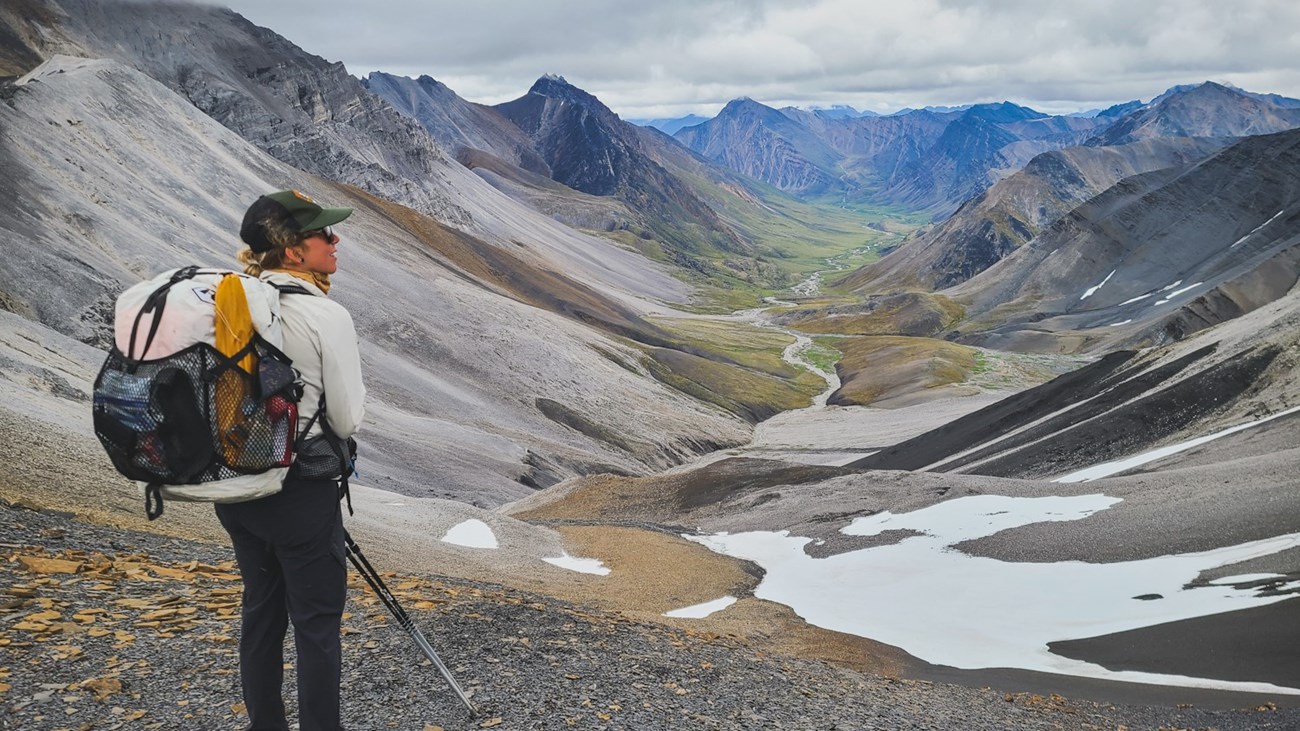
NPS/Josh Spice
Research and being prepared with tested and appropriate gear for any trip in Alaska can significantly reduce the probability of having a serious safety event. A trip into the Alaska backcountry is not the place to test new gear, clothing, or equipment.
Begin planning well ahead of your trip. Research what type of gear is recommended for the activities you are planning. Make a list of everything you’ll need so you have time to double check your gear. If parts are missing, items are torn or broke, this gives you time to replace or repair those items.
Wear test new or repaired clothing and footwear at home to break them in and make sure they will be comfortable. Same goes for gear, test everything at home or on shorter day trips or overnight trips to make sure you know how to properly use everything.
Pack Smart: Weather can change quickly. The most important food and supplies to consider:
-
High calorie food—Not only are you hiking, but it's often cold and rainy. That means your body will need more calories than usual.
-
Bug spray—Mosquitoes are typically a nuisance from May to September.
-
Tent—We strongly discourage bivy sacks. It's often raining, and bears are more likely to investigate bivvies than tents.
-
Gaiters—Stream crossings are common. Even if your gaiters aren't water-proof, they'll still help keep debris and rocks out of your boots. Many rivers are glacially-fed, and they carry a surprising amount of grit and rocks in their murky, fast water.
-
Trekking poles
-
Proper layers—Plan on temps ranging from as warm as 75 F to as cold as 20 F, possibly in the same day!
-
Bear spray—Note that this cannot be carried on planes or trains, nor can you drive through Canada with it. Plan on buying it in Alaska.
Detailed Gear Checklist: The following equipment is highly recommended when venturing out into Alaska's backcountry:
-
Sturdy hiking boots (waterproofed) and at least 2 pairs wool or synthetic socks. Nearly every backpacking trip involves crossing rivers or streams at some point.
- A backpack that can carry a tent, personal gear, and a Bear Resistant Food Container (BRFC). A rain-cover for your backpack is also recommended.
- An approved Bear Resistant Food Container (BRFC) to carry your food and scented items. This will help to protect you and the bear from negative encounters. In many areas of the backckountry there are no trees appropriate for hanging food. Coolers, ice chests, plastic packing boxes (totes, Action Packers, etc.) dry bags, blue dry barrels, tents and kayaks are not approved food storage containers. These take time to pack so plan ahead to obtain one.
-
Gaiters and trekking poles for river crossings, loose rock, snow patches, boggy areas, and brush.
-
Rain jacket and pants. Ponchos are not recommended—off-trail hiking usually involves walking through thick brush, which can snag and rip ponchos. It is also often windy here, making ponchos useless.
-
Warm, quick-drying clothing. Polypropylene, nylon, fleece or wool clothing (avoid cotton). Quick-drying pants, long underwear, at least one long-sleeved shirt, a warm winter hat, waterproof gloves and a fleece jacket are also recommended. Be prepared for temperatures ranging from 30° to 80° F (-1° to 27° C) in the summer months.
-
Stove, fuel, cookware and water bottles
-
Water filter (preferably equipped with a silt stopper device) or water purifying tablets. You'll fill water from clear creeks and ponds, which can carry giardia and other parasites or bacteria.
-
Dense, high-calorie food that fits in the Bear Resistant Food Container and cooks quickly.
-
Compass and map. While a GPS unit is useful, it should be used to supplement a topographic map, not in place of one. Because you won't know precisely where in the park you'll camp until you are here and acquire a permit, we recommend you wait to buy any USGS quadrant maps until you are here.
-
Sanitary items, e.g., toilet paper, trowel, a bag for used toilet paper and other items. All of this must be stored in the BRFC and packed out, not buried or burned.
-
Tent with rain fly and waterproof floor. Bivouacking or camping with only a tarp is not recommended.
-
Sleeping bag and pad. For any overnight summer trip, protection to 20° F/-7° C is suggested. Visitors coming in other seasons should be prepared for very cold temperatures.
-
Insect repellent and/or head net. Mosquitoes are usually bad from May to early August, although the biting insect season lasts another month in wetter parts of the park (e.g., around Wonder Lake).
-
Emergency gear, such as first aid kit, knife and a signaling device such as a whistle or signal mirror.
-
Large plastic or waterproof bags to protect the gear inside your pack, particularly if your pack is not water-proof. Even if you have a rain cover for your pack, keeping your clothes and sleeping bag in plastic trash bags within your pack is a smart idea.
-
A change of shoes for camp, to lower your impact on the vegetation and to change out of wet boots.
-
Waterproof case for your electronic device(s).
-
Sun protection (e.g., sunscreen, sunglasses, a hat). Plan for sunny or rainy weather, even though rainy weather is more likely.
-
Toiletries (e.g., toothbrush and toothpaste, hand sanitizer, lip balm). Remember, though: all of your items with an odor must fit in your Bear Resistant Food Container.
-
Bear spray. Carrying bear spray is up to you—it is not required, though it is recommended. However, bear spray is no substitute for behaving correctly in bear country, so do not be complacent or over-confident around wildlife simply because you have bear spray. Conditions must be ideal for bear spray to be effective (e.g. wind direction, weather, distance from the animal) and it is far better to learn how to behave safely in bear country than anything else.
Last updated: March 30, 2023
